ASM Metals HandBook Vol. 8 - Mechanical Testing and Evaluation
Подождите немного. Документ загружается.

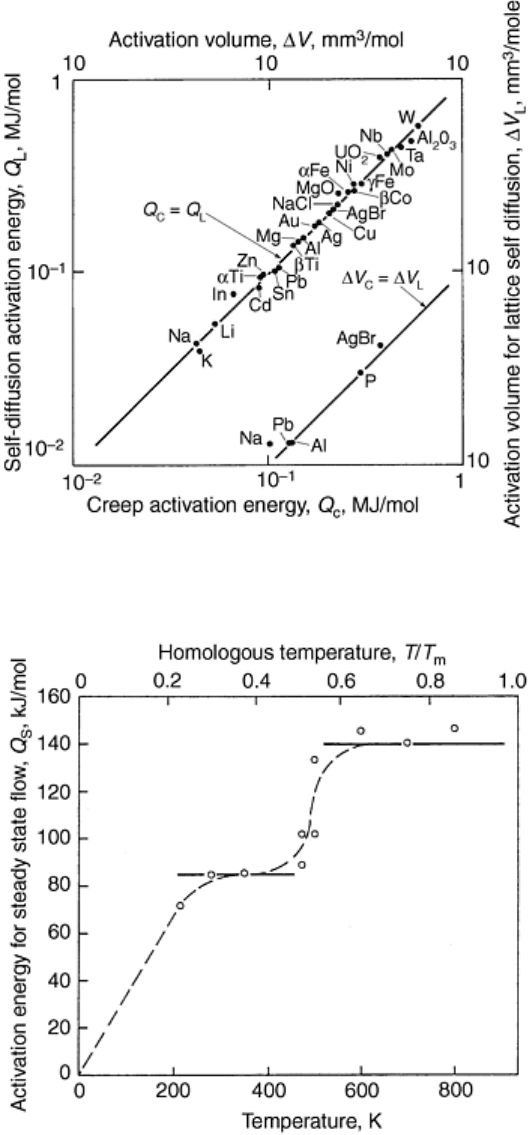
Fig. 3 Comparison of activation energies and activation volumes for steady state creep and lattice self-
diffusion for various materials above 0.5T
m
(Ref 1)
Fig. 4 Activation energy for steady state creep of pure aluminum as a function of temperature. Source:
Ref 1
The observation that high-temperature creep is controlled by lattice self-diffusion can be confirmed by
measuring the hydrostatic pressure dependence of creep. The relevant measured quantity is the activation
volume, ΔV. As shown in Fig. 3 for a limited set of available data, the activation volume for creep, ΔV
C
, is
equal to the activation volume for lattice self diffusion, ΔV
L
.
Creep of single phase materials exhibits a power law stress dependence as given by Eq 3, where n is normally
in the range of 4.5 to 5. Accordingly, this regime is often called power law creep. Although the observation of n
= 5 in the power law region is well documented for a variety of materials, it is important to recognize that
theoretical treatments can only rationalize a value of 3 or 4. This is often termed the natural creep law.
Representative data for pure aluminum are plotted in Fig. 5. These data illustrate that power law creep is
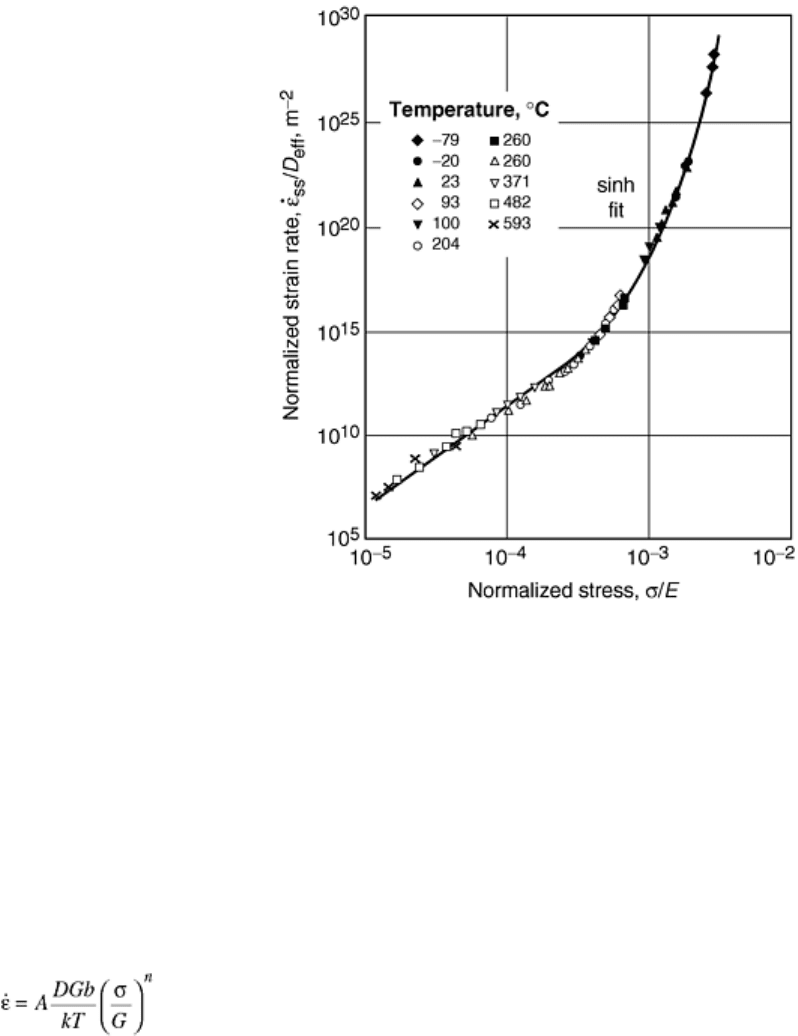
observed over many orders of magnitude of strain rate. However, above a normalized stress of about σ/E = 10
-3
(or a normalized shear stress, τ/G = 10
-3
), the creep rate begins to increase more strongly with applied stress.
From the perspective of power law creep, this region is described as power law breakdown and can be
described mathematically by an exponential or hyperbolic sine function as indicated in the figure. Alternatively,
this change in behavior may be considered a natural transition between high-temperature (power law)
deformation and low-temperature flow (Ref 1, 2).
Fig. 5 Steady state creep properties of pure aluminum presented as normalized strain rate as a function
of normalized stress. Source: Ref 1
Dislocation creep involves the interaction of the stress fields of moving dislocations with those of stationary
dislocations. Since the stresses surrounding a dislocation depend on the elastic modulus of the solid, the creep
rate is also expected to depend on elastic modulus. The most important contribution of modulus to
understanding the mechanisms of creep is that it introduces an additional temperature dependence to the creep
expression. For that reason, it is not important whether the elastic or shear modulus is considered, as long as the
correct variation with temperature is taken into account. In particular, analysis of creep data to determine the
activation energy must be based on a comparison of creep rates measured at constant values of stress
normalized by modulus, not at constant values of stress.
When these factors are taken into account, the resulting empirical creep equation can be written as:
(Eq 6)
where A is essentially a fitting parameter that includes additional effects of microstructure such as stacking fault
energy (Ref 3, 4). The parameter A must be determined from the data in order to calculate absolute values of the
creep rate. As noted earlier, most pure materials and solid solution alloys that exhibit pure metal behavior are
characterized by n values in the range of 4 to 8. Accordingly, measurement of values in this range can be taken
as evidence that the creep mechanism involves climb-controlled dislocation motion.
In ceramics, the high lattice friction, or Peierls stresses, low dislocation densities, and lack of sufficient slip
systems suggest that dislocation creep should be difficult. Nevertheless, at similar homologous temperatures
and normalized stresses, the creep behavior of many ceramics is similar to that of metals (Ref 3, 7, 8). In
particular, many ceramic materials also exhibit dislocation climb-controlled creep with n ≈ 5, although in other
cases a stress exponent closer to 3 is observed. Because subgrain structures are observed in these materials,
dislocation climb from Bardeen-Herring sources has been identified as the principal mechanism of deformation

in the latter case. In general, the observation of n = 3 in essentially pure ceramics provides evidence that the
material is not fully ductile, because it lacks the five independent slip systems required for general dislocation
glide deformation. This situation may be attributed to both crystallographic orientation effects and the relatively
high friction stresses associated with glide on some atomic planes in ceramics.
Creep in Alloys. As noted earlier, the creep curve for many solid solution strengthened alloys has a different
form (Fig. 2a) than that observed for pure materials (Fig. 1) (Ref 3, 9). In these materials, solute atom clusters
strongly interact with the stress fields of dislocations, and viscous glide of dislocations is the rate-controlling
process. The principal interaction mechanisms that impede dislocation glide include segregation of solute atoms
to dislocations, the destruction of short-range atomic order by gliding dislocations, and chemical interaction of
solute atoms with dissociated (partial) dislocations. In addition to the characteristic shape of the creep curve, the
behavior of these alloys differs from that of pure metals in that the stress exponent typically has a value of 3,
and dislocations do not form extensive subgrain structures during deformation. Finally, the activation energy
for creep generally equals that for self-diffusion of the solute atoms in the matrix. Together, these
characteristics identify a material that exhibits class A (for alloy) behavior, which can be contrasted with the
class M (for pure metal) response evidenced by alloys in which the dislocation/solute interactions are weaker
and n is typically equal to 5. Similar viscous glide behavior has been observed in ceramic solid solutions. Here
it is necessary to distinguish between glide-controlled creep and climb creep, described earlier. Both are
characterized by n = 3, but subgrain structures do not form when creep is glide controlled.
An empirical analysis of the creep behavior of a number of solid solution alloys indicates that it is possible to
predict whether an alloy will exhibit class M (climb-controlled) or class A (glide-controlled) behavior based on
knowledge of fundamental physical quantities (Ref 9). In particular, deformation by viscous dislocation glide is
expected when:
(Eq 7)
where e is the solute-solvent atom siz difference, c is the solute concentration, γ is the stacking fault energy of
the alloy, and B is a constant, which is estimated from creep data for the Al-3%Mg alloy. This relationship
correctly predicts the creep response of nearly all of the alloys to which it has been applied. As an example,
data for a number of solid solution alloys are plotted in Fig. 6 along with the line representing the predictions of
Eq 7. These data illustrate that the creep behavior of some alloys is controlled by the rate of dislocation glide
while other alloys exhibit climb controlled deformation. In contrast, the data for some alloys, such as Al-
3%Mg, reveal a transition from climb-controlled creep (n = 5) at low normalized stresses and normalized creep
rates to glide-controlled deformation (n = 3) at high stresses.
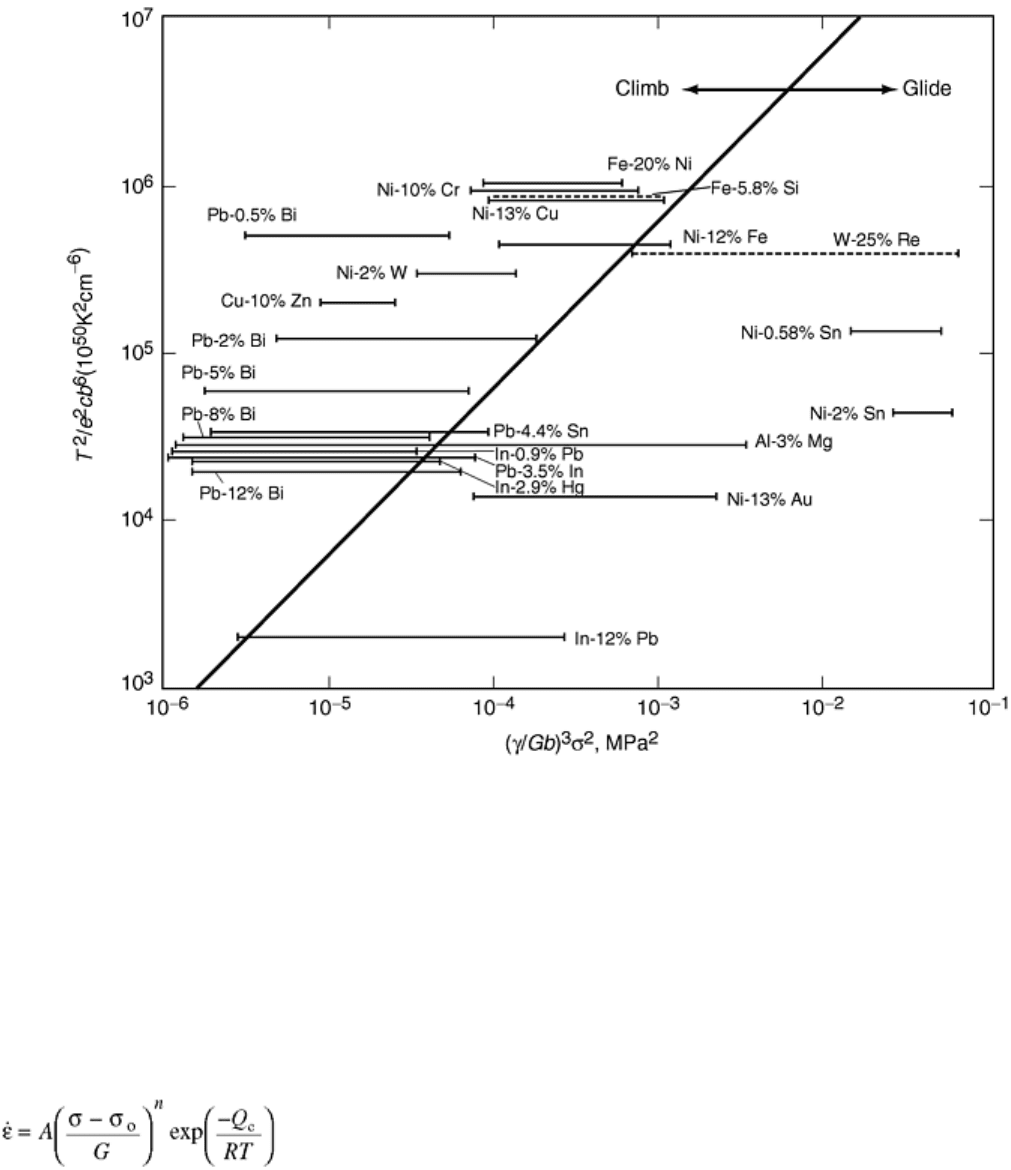
Fig. 6 Criterion for viscous glide controlled creep and dislocation climb controlled creep in solid solution
strengthened alloys. Source: Ref 9
Creep of Dispersion Strengthened Materials. One method to improve the creep resistance of materials for
elevated temperature applications is to add a uniform distribution of fine particles that block the motion of
dislocations. Creep tests of dispersion strengthened materials commonly reveal high stress exponents (on the
order of 20–100) and activation energies that are up to twice those for lattice diffusion (Ref 10). An example of
results for thoria-dispersed nickel-chromium alloys is illustrated in Fig. 7 (Ref 11). Phenomenologically, creep
of dispersion strengthened metals can be rationalized by introducing a threshold stress denoted by σ
o
into Eq 3
to account for the effect of the particles on the moving dislocations. The modified creep equation then takes the
form:
(Eq 8)
When a threshold stress is calculated from the creep data and included in the creep equation, the observed stress
exponents are approximately equal to 5, and the calculated activation energies agree with those for lattice self-
diffusion.
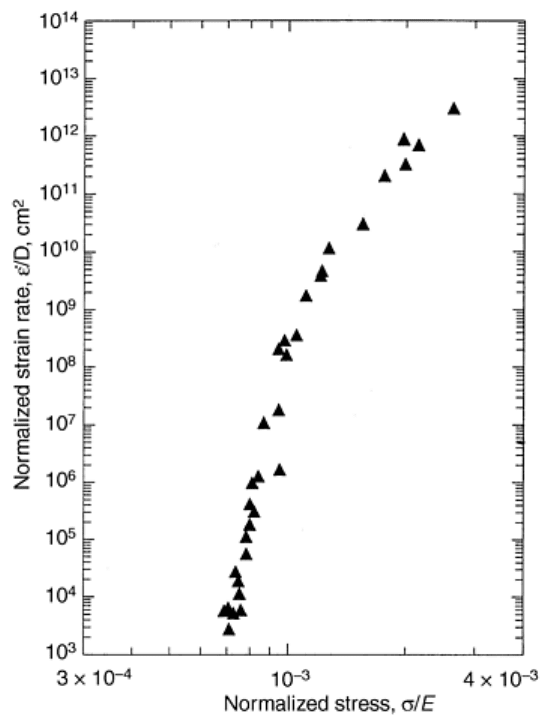
Fig. 7 Steady state creep results for a Ni-Cr alloy dispersion strengthened with ThO
2
. Source: Ref 11
At high stresses, gliding dislocations can pass the dispersoid particles by the process of Orowan bowing.
However, at the high temperatures and lower stresses that characterize creep deformation, it is more likely that
dislocations climb out of their glide planes to overcome the particles. Theoretical treatments of climb are based
on a mechanism in which only the segment of dislocation in the particle/matrix interface climbs (local climb) or
one in which a significant length of dislocation line near the particle leaves the glide plane (general climb).
While the climb process may introduce a threshold stress, its magnitude, as calculated from various models, is
generally too low to explain the experimental observations. Further, the relatively strong temperature
dependence of the threshold stress cannot be adequately explained by these theories. Thus, the threshold stress
approach provides a powerful method to correlate creep data for dispersion strengthened materials, but cannot
be fully justified on a theoretical basis.
A number of investigators have presented evidence from transmission electron microscopy (TEM) of creep
tested dispersion strengthened metals showing dislocations that appear to be bound to particles (Ref 10). The
distinctive feature of these micrographs is that the dislocations are stopped on the departure side of the particles
after having climbed over them. These observations demonstrate that the line energy of the dislocations is
reduced in the particle/matrix interface. Assuming that climb over the particles is relatively rapid, creep can
then be modeled by considering the thermally activated release of dislocations from the departure side of the
particles to be rate controlling. The resulting equation differs substantially from the usual form and contains
several parameters that are difficult to evaluate from the creep data. A satisfactory fit has been obtained for
creep data for a limited number of dispersion strengthened materials (Ref 10). Nevertheless, the TEM
observations present compelling evidence that dislocations interact strongly with particles on a very local scale.
Deformation Mechanism Maps. The mechanisms of dislocation glide, dislocation climb, and diffusional flow
exhibit different stress and temperature dependencies. Thus, the relative contribution of each process will
depend on the value of the applied stress, the temperature and microstructural features such as grain size. Ashby
has developed a graphical method to represent the conditions under which the various creep mechanisms
predominate (Ref 12).
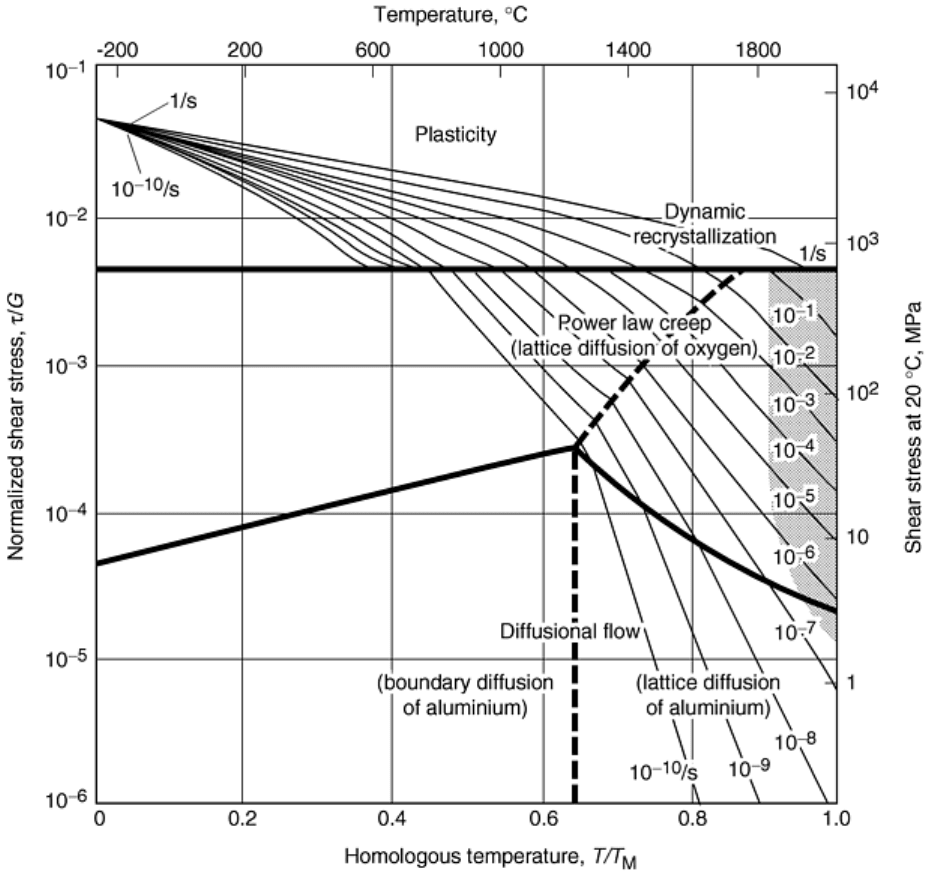
An example of this graphical approach, known as a deformation mechanism map, is presented in Fig. 8 for
creep of pure alumina (Al
2
O
3
) with a grain size of 100 μm. The axes of this map represent shear stress
normalized by the shear modulus and homologous temperature. Each field of the map represents the range of
stress and temperature over which a particular mechanism is expected to be the principal creep process. These
maps are created using experimental data to determine the necessary material properties and constants in
equations that describe each mechanism (such as Eq 4 and 6). Field boundaries are drawn where two
mechanisms contribute equally to the overall creep rate. In addition, lines of constant total strain rate are
superimposed as shown in Fig. 8.
Fig. 8 Deformation mechanism map for creep of pure alumina (Al
2
O
3
) with a grain size (d) of 100 μm.
Source: Ref 12
Maps of this type have been constructed for a variety of metals and ceramics (Ref 12). Specific knowledge of
the stress and temperature dependence of the various mechanisms provides a guide to material selection and
component design and suggests equations that should be used in a particular design analysis. Perhaps most
importantly, these maps can be used to identify an approach to designing materials for improved creep
resistance.
Creep of Composites. Structural composite materials are generally created by adding a reinforcing phase to
improve some aspect of the mechanical behavior of a matrix material. The primary goal in developing metal
matrix composites (MMCs) is to improve the specific stiffness and/or strength. In contrast, the motivation for
adding a reinforcing phase to a ceramic matrix composite (CMC) is usually to enhance fracture toughness.
Nevertheless, both MMCs and CMCs have generated considerable attention as candidate materials for high-
temperature applications where creep resistance is also of concern.
In most MMCs the reinforcement is a discontinuous ceramic phase (in the form of short fibers, whiskers, or
particulates). Further, these reinforcements are assumed to remain elastic, even at elevated temperatures. As a
consequence, the applied stress is shared by the matrix and reinforcement, resulting in a decreased stress in the
matrix compared to an unreinforced material. This load sharing effectively increases the creep resistance of the
composite. It is also important to recognize that the reinforcements are generally too large to interact with
individual dislocations as do precipitates and dispersoids.
The results of numerous investigations of metal matrix composites suggest that their creep behavior is largely
determined by the creep characteristics of the matrix in terms of the stress exponent and activation energy (Ref
13). When the effects of load sharing and redistribution are taken into account, the magnitude of the creep rate
can also be predicted with reasonable accuracy. In many cases, MMCs appear to exhibit characteristics similar
to dispersion-strengthened metals, including high stress exponents and activation energies as well as apparent
threshold behavior. These characteristics generally reflect the fact that the material is prepared by powder
processing methods that may also incorporate fine dispersoids in the matrix. These dispersoids control the
matrix creep response, which dominates the response of the composite.
The creep response of multiphase ceramics depends on the relative volume fractions of the matrix and
reinforcement phase (Ref 14). As with MMCs, it is usually assumed that the reinforcing phase is rigid and that
deformation occurs in the matrix, although this idealization may not always hold true for CMCs. At low volume
fractions of reinforcement, the particles behave independently of one another. In this case, creep is controlled
by power law deformation in a crystalline matrix or (linear) viscous flow (if the matrix is amorphous). The
results of creep studies of low volume fraction materials reveal little improvement in creep strength. As the
volume fraction of reinforcement is increased, the creep resistance increases dramatically. For example, when
the volume fraction of whiskers in a CMC exceeds 15%, the creep rate falls by 1 to 2 orders of magnitude from
the rate observed in the unreinforced matrix. This improvement appears to be essentially independent of volume
fraction of reinforcement in the range 15 to 50%. Finally, at high volume fractions, the creep behavior can be
described as highly constrained flow of the matrix material coupled with cavitation. Often, this situation arises
in liquid phase sintered materials with an amorphous grain boundary phase. Additional complications in
describing creep arise if the reinforcements form a continuous network.
References cited in this section
1. W.D. Nix and J.C. Gibeling, Mechanisms of Time-Dependent Flow and Fracture of Metals, Flow and
Fracture at Elevated Temperatures, R. Raj, Ed., American Society for Metals, 1985, p 1–63
2. B. Ilschner and W.D. Nix, Mechanisms Controlling Creep of Single Phase Metals and Alloys, Strength
of Metals and Alloys, Vol 3, P. Haasen et al., Ed., Pergamon Press, New York, 1980, p 1503–1530
3. O.D. Sherby and P.M. Burke, Mechanical Behavior of Crystalline Solids at Elevated Temperature,
Prog. Mater. Sci., Vol 13 (No. 7), 1967, p 325–390
4. A.K. Mukherjee, J.E. Bird, and D.E. Dorn, Experimental Correlations for High Temperature Creep,
ASM Trans. Quart., Vol 62, 1969, p 155–179
6. W. Blum, High-Temperature Deformation and Creep of Crystalline Solids, Plastic Deformation and
Fracture of Materials, H. Mughrabi., Ed., VCH, 1993, p 359–405
7. W.R. Cannon and T.G. Langdon, Review: Creep of Ceramics, Part 1, J. Mater. Sci., Vol. 18, 1983, p 1–
50
8. W.R. Cannon and T.G. Langdon, Review: Creep of Ceramics, Part 2, J. Mater. Sci., Vol 23, 1988, p 1–
20
9. F.A. Mohamed and T.G. Langdon, The Transition from Dislocation Climb to Viscous Glide in Creep of
Solid Solution Alloys, Acta Metall., Vol 22 (No. 6), 1974, p 779–788

10. E. Arzt, Creep of Dispersion Strengthened Materials: A Critical Assessment, Res Mech., Vol. 31, 1991,
p 399–453
11. R.W. Lund and W.D. Nix, High Temperature Creep of Ni-20Cr-2ThO
2
Single Crystals, Acta Metall.,
Vol 24, 1976, p 469–481
12. H.J. Frost and M.F. Ashby, Deformation Mechanism Maps: The Plasticity and Creep of Metals and
Ceramics, Pergamon Press, Oxford, 1982
13. J.C. Gibeling, Interpretation of Threshold Stresses and Obstacle Strengths in Creep of Particle-
Strengthened Materials, Creep Behavior of Advanced Materials for the 21st Century, R.S. Mishra, A.K.
Mukherjee, and K.L. Murty, Ed., The Minerals, Metals and Materials Society, 1999, p 239–253
14. D.S. Wilkinson, Creep Mechanisms in Multiphase Ceramic Materials, J. Am. Ceram. Soc., Vol 81,
1998, p 275–299
Creep Deformation of Metals, Polymers, Ceramics, and Composites
Jeffery C. Gibeling, University of California, Davis
Creep Response of Amorphous Solids
In contrast to the crystalline solids described in the previous section, glasses and many polymers have an
amorphous atomic or molecular structure. Although these materials are not usually intended for structural
applications in which resistance to creep deformation is a design consideration, their creep behavior is
important in both processing and service. Many amorphous materials undergo viscoelastic deformation, which
includes elastic, anelastic, and viscous plastic strain. Both anelastic and viscous deformation are commonly
referred to as creep, although only the latter is permanent. To remain consistent with previous descriptions of
creep, only the permanent, viscous deformation of amorphous solids is considered here.
A useful representation of the creep response of amorphous solids above the glass transition temperature is
given by a simple expression for the rate of linear viscous flow:
(Eq 9)
where τ is the shear stress, is the shear strain rate, and η is the structure- and temperature-dependent viscosity
that is a function of the activation enthalpy (ΔH) as follows:
(Eq 10)
Thus, creep in amorphous solids is a thermally activated process. In terms of tensile quantities, Eq 9 can be
rewritten as:
(Eq 11)
While the preceding expressions adequately represent the behavior of both glasses and polymers, these two
classes of materials differ significantly in their mechanisms of creep. These microstructural differences are
reflected in the viscosities of the materials. In polymers, particularly those characterized as thermoplastics, the
rate controlling creep mechanism involves cooperative motion of molecular chain segments with respect to one
another. The rate and extent of creep strain decreases with increasing density of cross links between the
molecular chains. Increasing molecular weight (resulting in longer molecular chains) also reduces the creep
rate, but to a less significant extent. In glasses, the mobility of groups of atoms within the network of glass

forming oxides (such as SiO
2
) determines the resistance to creep deformation. Network modifiers that break up
the continuity of the network reduce the viscosity, thereby promoting higher creep rates (and easier
formability).
Many engineering polymers also exhibit a phenomenon known as stress relaxation. In essence, stress relaxation
is creep under conditions of constant total length, such that elastic strain is gradually converted to permanent
plastic strain. This causes both the stress and the strain rate to decrease with time. However, the underlying
mechanisms are essentially the same as for creep deformation.
Finally, we note that polymer matrix composites (PMCs) also exhibit creep deformation (Ref 15). In general,
measurements of activation energy and activation volume reveal that the addition of stiff fibers does not alter
the mechanism of deformation in the polymer matrix. However, an adequate description of the creep behavior
of PMCs requires consideration of the volume replacement effect that gives rise to a stress redistribution and
the role of constraint of deformation as the fibers essentially stiffen the matrix. Thus, the role of the
reinforcements is similar in the case of crystalline matrix and amorphous matrix composites.
Reference cited in this section
15. J. Raghavan and M. Meshii, Creep of Polymer Composites, Compos. Sci. Technol., Vol 57, 1997, p
1673–1688
Creep Deformation of Metals, Polymers, Ceramics, and Composites
Jeffery C. Gibeling, University of California, Davis
References
1. W.D. Nix and J.C. Gibeling, Mechanisms of Time-Dependent Flow and Fracture of Metals, Flow and
Fracture at Elevated Temperatures, R. Raj, Ed., American Society for Metals, 1985, p 1–63
2. B. Ilschner and W.D. Nix, Mechanisms Controlling Creep of Single Phase Metals and Alloys, Strength
of Metals and Alloys, Vol 3, P. Haasen et al., Ed., Pergamon Press, New York, 1980, p 1503–1530
3. O.D. Sherby and P.M. Burke, Mechanical Behavior of Crystalline Solids at Elevated Temperature,
Prog. Mater. Sci., Vol 13 (No. 7), 1967, p 325–390
4. A.K. Mukherjee, J.E. Bird, and D.E. Dorn, Experimental Correlations for High Temperature Creep,
ASM Trans. Quart., Vol 62, 1969, p 155–179
5. R.W. Evans and B. Wilshire, A New Theoretical and Practical Approach to Creep and Creep Fracture,
Proc. Seventh International Conf. Strength of Metals and Alloys, H.J. McQueen, J.-P. Bailon, J.I.
Dickson, J.J. Jonas, and M.G. Akben, Ed., Pergamon Press, Oxford, 1986, p 1807–1830
6. W. Blum, High-Temperature Deformation and Creep of Crystalline Solids, Plastic Deformation and
Fracture of Materials, H. Mughrabi., Ed., VCH, 1993, p 359–405
7. W.R. Cannon and T.G. Langdon, Review: Creep of Ceramics, Part 1, J. Mater. Sci., Vol. 18, 1983, p 1–
50
8. W.R. Cannon and T.G. Langdon, Review: Creep of Ceramics, Part 2, J. Mater. Sci., Vol 23, 1988, p 1–
20
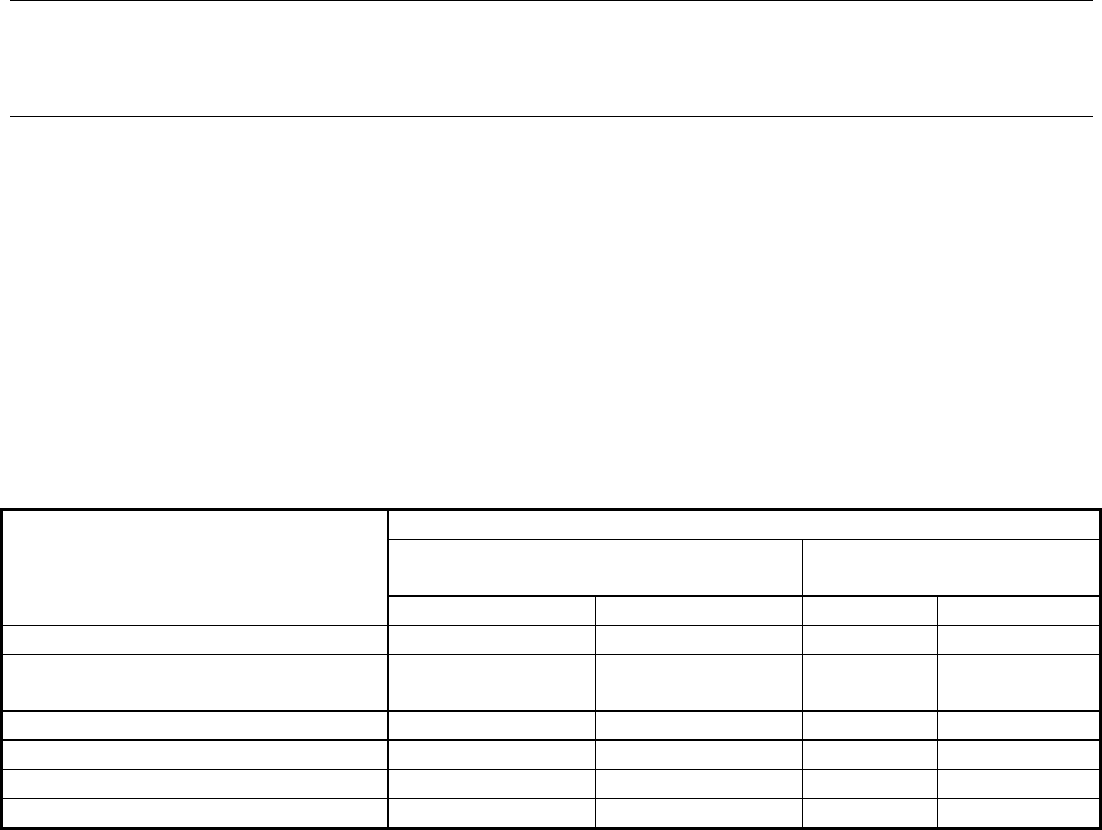
9. F.A. Mohamed and T.G. Langdon, The Transition from Dislocation Climb to Viscous Glide in Creep of
Solid Solution Alloys, Acta Metall., Vol 22 (No. 6), 1974, p 779–788
10. E. Arzt, Creep of Dispersion Strengthened Materials: A Critical Assessment, Res Mech., Vol. 31, 1991,
p 399–453
11. R.W. Lund and W.D. Nix, High Temperature Creep of Ni-20Cr-2ThO
2
Single Crystals, Acta Metall.,
Vol 24, 1976, p 469–481
12. H.J. Frost and M.F. Ashby, Deformation Mechanism Maps: The Plasticity and Creep of Metals and
Ceramics, Pergamon Press, Oxford, 1982
13. J.C. Gibeling, Interpretation of Threshold Stresses and Obstacle Strengths in Creep of Particle-
Strengthened Materials, Creep Behavior of Advanced Materials for the 21st Century, R.S. Mishra, A.K.
Mukherjee, and K.L. Murty, Ed., The Minerals, Metals and Materials Society, 1999, p 239–253
14. D.S. Wilkinson, Creep Mechanisms in Multiphase Ceramic Materials, J. Am. Ceram. Soc., Vol 81,
1998, p 275–299
15. J. Raghavan and M. Meshii, Creep of Polymer Composites, Compos. Sci. Technol., Vol 57, 1997, p
1673–1688
Creep and Creep-Rupture Testing
*
Introduction
CREEP PROPERTIES are important in the design of components that are subjected to stresses at elevated
temperatures for prolonged periods. In order to use materials for high-temperature components, it is essential to
measure and evaluate the creep behavior of the material as a function of time. This may include creep tests
and/or creep-rupture tests. Creep tests measure the amount of creep strain as a function of time, while creep-
rupture tests measure the time to fracture for a given temperature and stress levels. Both tests have engineering
application depending on design criteria. In some cases, the amount of creep strain is a design factor, while
stress rupture is the design criterion in other cases. For example, Tables 1 and 2 list maximum-use temperatures
in specific applications with different design criteria.
Table 1 Temperature limits of superheater tube materials covered in ASME Boiler Codes
Maximum-use temperature
Oxidation/graphitization
criteria, metal surface
(a)
Strength criteria,
metal midsection
Material
°C °F °C °F
SA-106 carbon steel 400–500 750–930 425 795
Ferritic alloy steels
0.5Cr-0.5Mo
550 1020 510 950
1.2Cr-0.5Mo 565 1050 560 1040
2.25Cr-1Mo 580 1075 595 1105
9Cr-1Mo 650 1200 650 1200
Austenitic stainless steel 760 1400 815 1500
